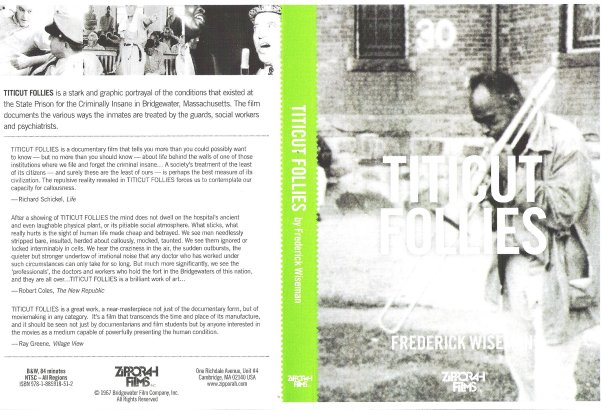
Titicut Follies could quite possibly be the most disturbing documentary ever made, and Frederick Wiseman could quite possibly be the best documentarian that ever lived simply because the man's eye and camera lens seemed to be as one. Watching Wiseman scan a scene and pick up minute details and then pan to another detail is a wonder to watch. It's quite the opposite of Riefenstahl's panoramic work, but every bit as amazing.
Wiseman's documentary was filmed in 1966 at the Bridgewater hospital for the criminally insane, and was quickly banned for over 20 years by the Massachusetts Supreme Court, who ruled that the film had "invaded the privacy of the Bridgewater inmates". If there ever was an instance where an invasion of privacy was necessary to shed light on an injustice, then Titicut Follies was it. The film helped for the better to change the way that State hospitals were run, and it's still as sobering a film as it was in 1967.
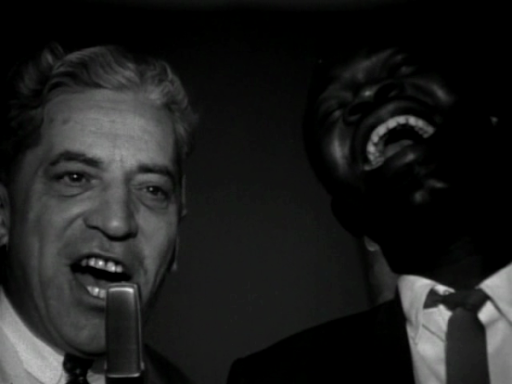
From Sense of Cinema:
Time certainly changes the viewing experience of any film, but especially so in the case of Frederick Wiseman's first documentary, which editorially chronicles the facilities and the patients at a state-run treatment center. In the mid-1960s, MCI-Bridgewater held a wide range of detainees and patients, some deemed “criminally insane” and others “sexually dangerous”. Despite the sensitive treatment these inmates required, the center was nevertheless run – at the time – by the Department of Corrections, not the Department of Mental Health.
The film's initial production in 1967 quickly brought controversy: consent procedures were called into question, as were the ethics of both the first-time filmmaker and his political cronies, and finally, legal definitions of terms like 'privacy' and 'obscenity' (the State tried to restrict the film's exhibition based partially on the grounds that the film showed male frontal nudity). Titicut Follies became at once a hot topic for newspapers, a useful document for rights activists (as well as for students of documentary), and a deeply sensitive issue for the families personally involved.
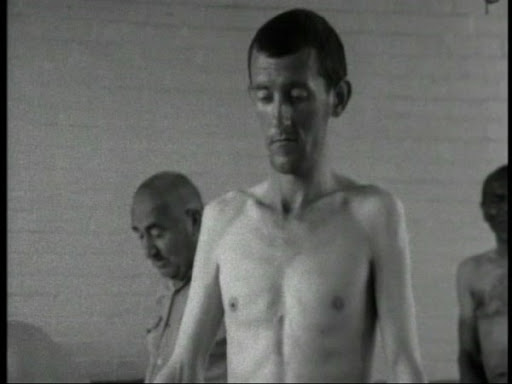
But now, in 2002, Wiseman has made over 30 films and is generally regarded to be one of the most unique and stylistically uncompromising documentary filmmakers. Unaffiliated with any school of filming (or indeed with any film school), Wiseman has steadfastly pursued a completely individualized style of production, ranking him with the great auteurs and filmic innovators in cinema history. Discussions of Titicut Follies used to be more about the patients – should their rights of privacy be protected, did Wiseman violate those rights, how the issue of consent is complicated when competency can't be established, and so on. Now, with the most pressing legal suits in the film's past, and with many of the patients pictured now deceased, the film becomes more our chance to see the seeds of Wiseman's style at their rawest roots.
Wiseman's camera is deceptively passive, deceptively silent. An understandable but inappropriate impression is that it merely sits back and watches. In Titicut Follies, patients are stripped and humiliated by boorish guards operating under questionable government policy, and Wiseman's camera keeps rolling. It enters a session between a doctor interviewing an inmate, who admits to molesting his own daughter. It takes us inside the morgue as Bridgewater's embalmer prepares a body for burial. To what degree is Wiseman's camera brave for recording and presenting events we'll otherwise never see? And to what degree is it cold, or voyeuristic? Which events does it passively record, and which does it catalyze?
For instance, a patient named Jim is taunted relentlessly by a guard abusing his authority. Naked and being led through the halls – followed by Wiseman's camera – Jim is put further in a position of inferiority when placed in a barber's chair, loomed over by multiple officers, shaved roughly (perhaps even being cut purposefully), and taunted all the way back to his empty cell, bleeding and covering his genitals. But when the guards finally give out, appearing to leave Jim alone, Wiseman keeps going. His camera stands in the doorway of Jim's cell, rolling on, watching, giving Jim no respite, effectively continuing his harassment while simultaneously exposing it. The viewer is put in an extremely uncomfortable position, forced to react multiply to varying stimuli – Jim's disgustingly inappropriate cell, off-camera guards restarting their psychological torment, Jim's tantrum in response. Wiseman's camera (by implication, the viewer), stands at the doorway and watches. When the camera zooms in, it feels like an attack. Only then, at the very end of the sequence, do we learn that Jim was a school teacher, bringing his painful story up front with a powerful immediacy. And lest we think that Wiseman's camera manhandles his subjects at all times, he's careful to include the speeches of a patient named Vladimir, who cleverly argues with the doctor as often as possible on camera, fully aware of the agency he's being given to plead his own case.
Wiseman's silent camera has never needed a narrator, though, in presenting institutions that the public would otherwise have never had access to – for example, the underground training facilities at Vandenberg Air Force base (where recruits are trained to push 'the button') in Missile (1987), the workings of a Midwestern police department in Law and Order (1969), and, most recently, the procedures inside a women's shelter in Tampa, Florida in Domestic Violence (2001).
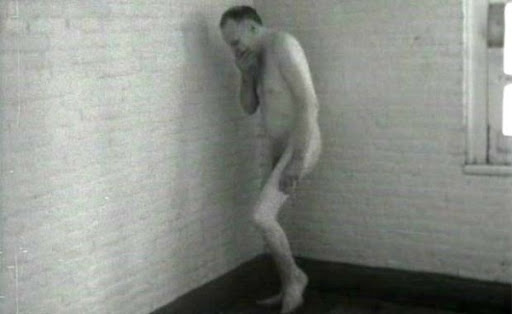
Making private matters public seems to imply a distinct political agenda, however in 1967, Wiseman was (perhaps above all) an ambitious artist. Do we then qualify his efforts? The film, after all, which did help to bring change to the facility, is not a clearly argued social document, but rather it's structured, dryly, as a musical. It's even bookended by performances. Patients burst out of their prison-like confines, perpetually singing and playing instruments and spouting off semi-comprehensible theories on contemporary domestic and foreign policy. Wiseman also presents the 'cast of characters' so that we're not entirely sure at first who's a guard and who's a patient.
Though Wiseman's heavy-handedness is apparent in some episodes of didactic editing, these one-sided cuts show us the gross and pathetic effects of bureaucracy at the institution. An old patient, mistreated to the point where he commits to starve himself to death, is stripped naked, thoroughly disrespected, and force-fed through the nose with a rubber tube lubricated with grease (as the doctor's cigarette dangles precariously above the funnel). Intercut with this sequence, however, is his death, in which he is given a suit, an embalming, a processional in a hearse, and a proper coffin burial presided over by a priest.
But the question with a Wiseman film always is: what emotion do you feel? Is Wiseman presenting the horror of this man's personal fate or coldly ruing bureaucratic inefficiency?
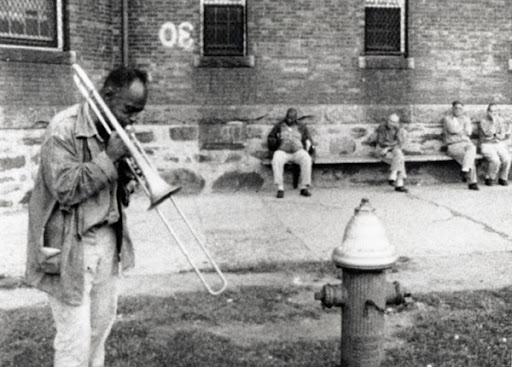
Technical Information:
Title: Titicut Follies
Year: 1967
Country: U.S.A.
Director: Frederick Wiseman
Source: Retail NTSC DVD5
DVD Format: DVD5
Container: VIDEO_TS
Size: 4.01 GB
Length: 1:23:54
Programs used: Unknown
Resolution: 720X480
Aspect Ratio: 4:3
Video: MPEG-2 @ ~6800 kb/s
Frame Rate: 29.97
Audio: English- Dolby AC3 Stereo @ 192 kb/s
Subtitles: None
Menu: Yes
Video: Untouched
DVD Extras: None on source
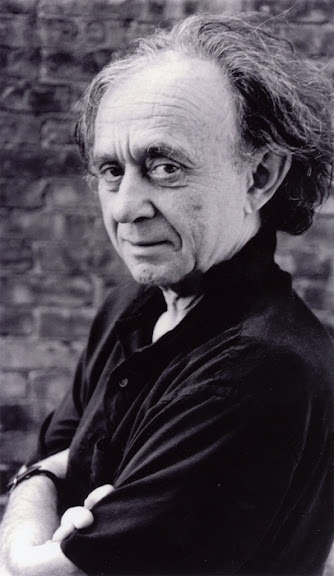
(Use JDownloader to automate downloading)
Titicut Follies Megaupload Links



